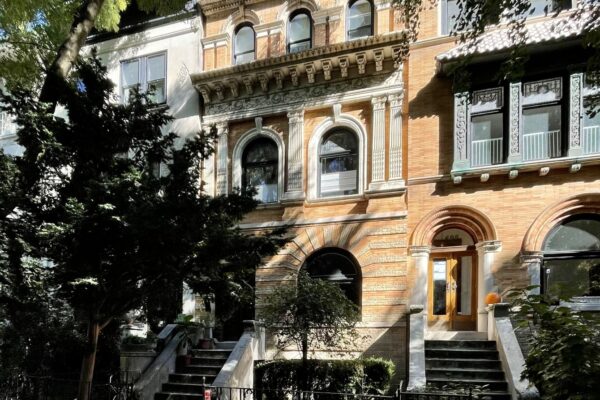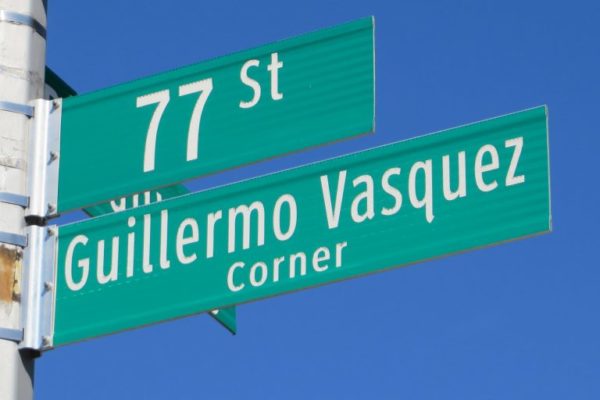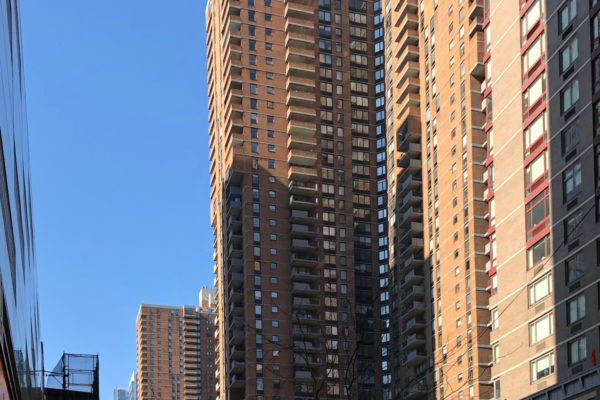
Impact of AIDS
overview
At its height in the 1980s and 1990s, the AIDS epidemic had a devastating impact on the New York City landscape, with the gay and trans communities being among the hardest hit.
The staggering loss of life affected entire industries, particularly the arts and related fields. Gay nightclubs and bathhouses were either forced to close as part of the City of New York’s controversial anti-AIDS measures or because large numbers of patrons had died from the disease.
In addition to those shuttered nightlife spaces, this curated theme remembers gay and trans people who died of AIDS by highlighting their residences, public art, gravesites, and places of work or performance where they were leaders in their fields.
See our curated theme, The AIDS Crisis, for historic sites connected to AIDS activism and organizing.
Historic Sites in Impact of AIDS
The American Museum of Natural History has been affiliated with numerous LGBT individuals, including Margaret Mead, Colin Turnbull and Joseph Tulles, Alexander von Humboldt, and Frederica Leser. In 1973, as... Learn More
Fashion illustrator Antonio Lopez and art director Juan Ramos had a 27-year professional collaboration that reinvigorated and redefined fashion illustration at a time when photography was being prioritized for advertising.... Learn More
Best known for his 1970s Frog and Toad picture books, heralded as classics of children’s literature, award-winning author and illustrator Arnold Lobel lived in this Park Slope rowhouse from 1973... Learn More
From 1981 until his death from AIDS-related complications in 1994, Assotto Saint lived in apartment 2D of this Chelsea building with his life partner, Jan Urban Holmgren. As a Haitian-born... Learn More
The Chelsea Hotel, the storied residence hotel on 23rd Street, has played host to a succession of countercultures throughout the 20th century, serving as a hub and inspiration for the... Learn More
Since 1869, Hart Island has been the site of the city’s public cemetery for burials of people who died indigent or whose bodies went unclaimed. Beginning in the mid-1980s and... Learn More
The Dakota, the famed apartment building on Central Park West, has long been a home for celebrities, including notable LGBT people in the arts. Former residents include composer Leonard Bernstein,... Learn More
A rare surviving Harlem building that hosted drag balls, the Imperial Lodge of Elks (also referred to as the Elks Lodge) was prominently featured in the documentary Paris Is Burning (1990), which... Learn More
The Everard Baths, one of the most legendary of New York’s bathhouses, was a refuge for gay men probably since its opening in 1888, but definitely by World War I. As... Learn More
Beginning in the year 2000, plaques have been installed along Seventh Avenue — a corridor synonymous with the fashion industry — to commemorate internationally renowned fashion designers. Gay fashion designers... Learn More
Artist Félix González-Torres was known for his conceptual, minimalist art installations that employed everyday objects to reflect on his experiences as an openly gay Cuban-American wrestling with both the personal... Learn More
From 1976 until his death in 2018, Geoffrey Hendricks, a painter and early gay performance artist central to Fluxus, lived in this rowhouse with his two long-term partners, first with... Learn More
Many LGBT individuals are buried at Green-Wood Cemetery in Brooklyn, one of the most beautiful landscapes in America. Here one can visit the gravesites of such famous individuals as Leonard... Learn More
Guillermo Vasquez was a leading gay rights, AIDS, and Latino community activist in Queens who emigrated from Colombia in 1972. Seventeen years after his 1996 death from AIDS-related complications, this... Learn More
In 1966, real estate lawyer Alexander Hirsch and his partner Lewis Turner commissioned architect Paul Rudolph to remodel their residence (a former 19th-century carriage house) and design a new facade.... Learn More
Between the fall of 1983 and early 1986, the full third floor of this building was the first office of the Institute for the Protection of Lesbian and Gay Youth... Learn More
In 1986, Black fashion designer Isaia, known for his use of Lycra to create body-conscious styles for women, moved his clothing label to a loft in this building just as... Learn More
In 1986, Keith Haring painted his iconic Crack is Wack mural on a handball court wall visible from the Harlem River Drive (the mural there today is actually his second... Learn More
The artist Keith Haring worked in a fifth-floor studio in this building from 1985 to 1990, the last five years of his life before dying of AIDS. In this time... Learn More
The foremost all-male ballet company in the U.S. and one of the most popular dance companies in the world, Les Ballets Trockadero de Monte Carlo held its debut performances at... Learn More
In 1972, Queens schoolteacher Jeanne Manford publicly spoke out in support of her gay son Morty at a time when homosexuality was still classified as a mental disorder by the... Learn More
Known as “Broadway’s Bedroom,” Manhattan Plaza is a subsidized housing complex predominantly restricted to people working in the performing arts. Opened in 1977 shortly before the onset of the AIDS... Learn More
Widely regarded as one of the most important openly gay Puerto Rican writers of the 20th century, Manuel Ramos Otero developed an explicitly gay literature that transcended the canons of... Learn More
Martin Wong was a Chinese American artist and influential figure in the 1980s and early 1990s downtown arts scene. While living in this Lower East Side tenement building, from 1982... Learn More
This Greek Revival rowhouse was the home of innovative record executive Melvin “Mel” Cheren and Paradise Garage founder Michael Brody beginning in 1973. In 1982, Cheren, an early AIDS activist,... Learn More
In 1986, following the death of his partner Leslie Blanchard, Miguel Braschi received an eviction notice from the landlord of the apartment they had shared for ten years because he... Learn More
The New St. Marks Baths was one of the largest and most renowned bathhouses in New York City from 1979 to 1985. Its owner, Bruce Mailman, became a central figure... Learn More
From 1944 to 1966, New York City Center was the first home of New York City Opera, which featured the works and talents of several notable gay composers and conductors.... Learn More
Paul Thek, who lived and worked at 254 East 3rd Street in at least the late 1960s, was a visual artist and one of the first to create installation art.... Learn More
Photographer Peter Hujar was barely recognized in his lifetime but, since his death due to AIDS-related pneumonia in 1987, he has come to be regarded as one of the greatest... Learn More
The openly gay, Iranian-born director and playwright Reza Abdoh lived in an apartment in this building near Times Square with his partner, actor Brenden Doyle, from at least 1993 until... Learn More
Richard Hunt was a prominent Muppet performer at The Jim Henson Company, working there from 1969 until shortly before his death, due to AIDS-related complications, in 1992. His first big... Learn More
Robert Mapplethorpe was one of the most influential and controversial photographers of the 20th century, known as much for his unflinching depictions of gay sado-masochistic sex as the outrage they... Learn More
From the early 1970s until his untimely death from AIDS-related complications in 1994, activist Robert Rygor lived in apartment 3B of this Greenwich Village building. Rygor, who was half Irish,... Learn More
Gay rights activist Ron Jacobowitz, who lived in this apartment building from 1986 to 1994, co-founded Gay Men of the Bronx as well as Bronx Lesbian and Gay Men United... Learn More
As an art curator and collector, Sam Wagstaff almost single handedly drove the market in the acquisition of photographs by private collectors, art galleries and museums in the 1970s and... Learn More
Scott Burton, a major figure in the New York art scene of the 1970s and 1980s, specialized in the creation of public installations that combined furniture design and sculpture. Among... Learn More
The openly gay photographer Tseng Kwong Chi, a central figure in the 1980s downtown arts scene, lived and worked in a loft in this Chelsea building from 1980 to 1989,... Learn More
Vernon E. Berg, III, known as Copy Berg, was the first naval officer to challenge the military’s ban on gay and lesbian sailors. Although he lost his bid for reinstatement,... Learn More
Víctor Fragoso was one of the first Puerto Rican poets and playwrights whose work focused on issues of gender, homosexuality, and the life of the Puerto Rican diaspora in the... Learn More
Best remembered for his pioneering book The Celluloid Closet: Homosexuality in the Movies, Vito Russo was also a significant gay rights and AIDS activist in the 1970s and 1980s. He lived... Learn More
Woodlawn Cemetery in the northern Bronx is not only a magnificent park-like landscape, but is the final resting place of many notable figures in the history of the United States.... Learn More














































